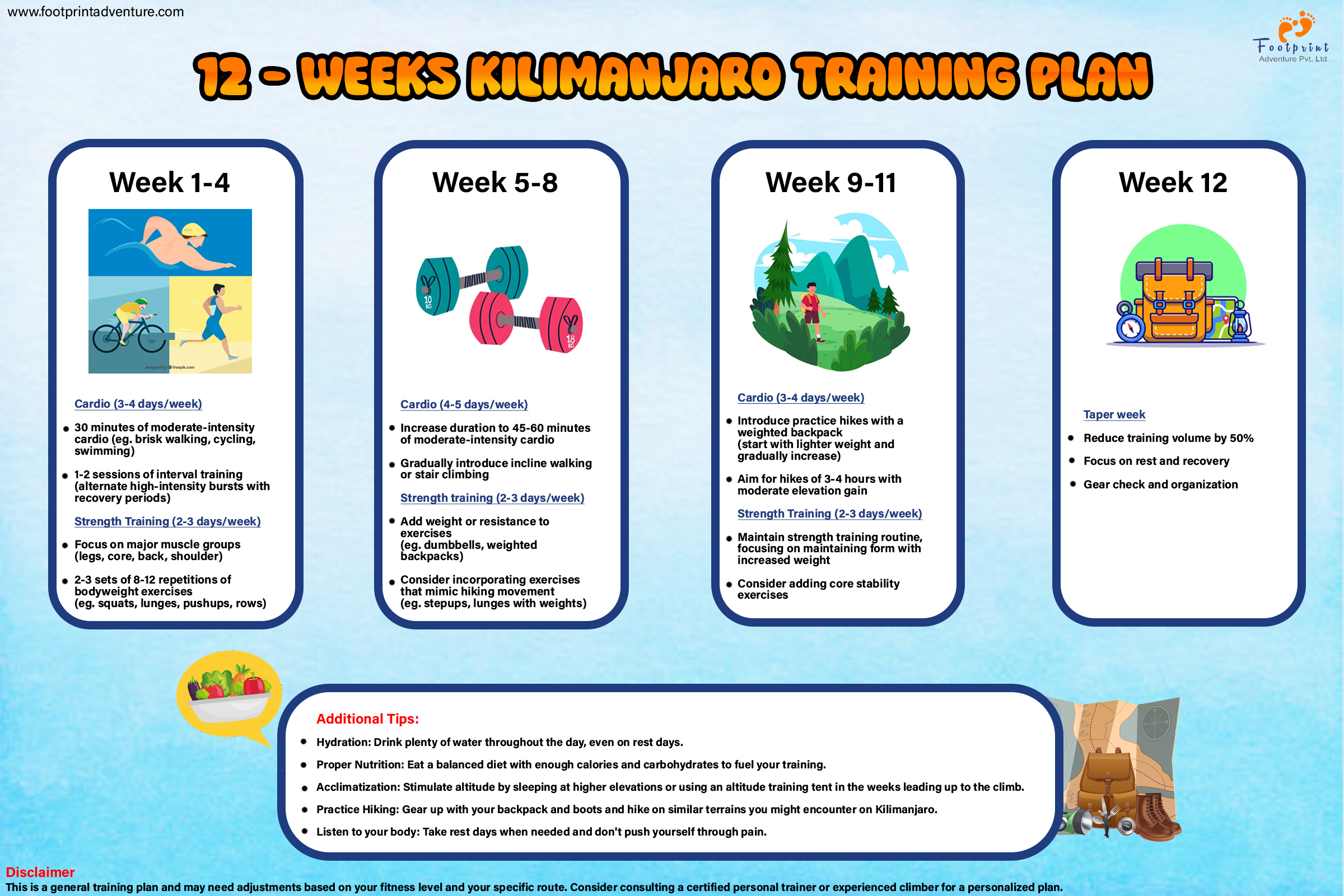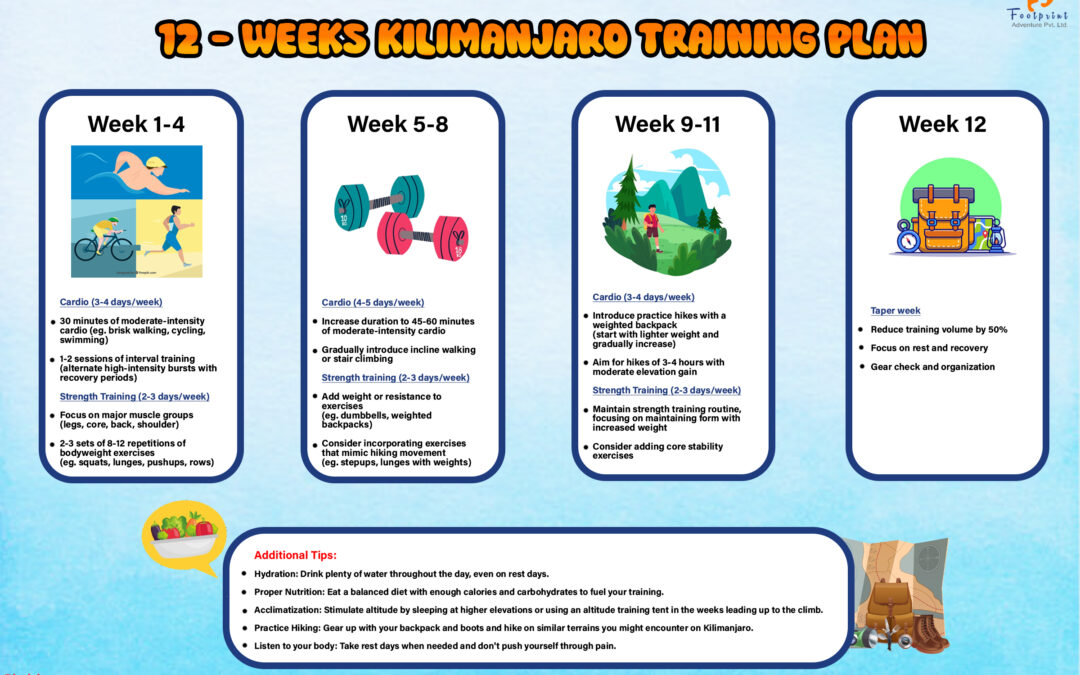Would you believe that even with a desk-bound job, you could be ready to climb Mount Kilimanjaro in just 12 weeks? It’s true! Several professionals have seen the summit thanks to a structured training plan tailored for those with sedentary lifestyles.
The Kilimanjaro Training Plan for Sedentary Jobs spans 12 weeks and incorporates gradual increases in physical activity. This schedule is designed with the realities of office work in mind, ensuring flexibility. Interestingly, research shows that people with desk jobs can significantly improve their fitness levels by committing to this well-structured plan.

Kilimanjaro Training Plan for Sedentary Jobs: 12-Week Schedule
Preparing for Kilimanjaro can be daunting, especially if you have a sedentary job. The 12-week schedule by Rashad Adventures is designed to gradually build your fitness level. In the first few weeks, you start with light exercises and stretches. This helps your body adapt to the new routine. By focusing on consistency, you set a solid foundation.
Weeks 1 to 4 are all about establishing a fitness base. You will incorporate basic cardio and strength training. This can include activities such as walking, light jogging, and simple bodyweight exercises. The goal here is to increase stamina and introduce movement into your daily routine. Consistency is key here.
Once you move to weeks 5 to 8, the intensity ramps up. During this phase, you will start incorporating longer hikes and steeper climbs. Strength and endurance workouts become more intense. According to this post, this is where your body starts adapting to more challenging terrains. It’s crucial to stick to the plan to avoid injuries.
By weeks 9 to 12, you’re preparing for the real deal. Simulation and acclimatization are critical. Hikes should mimic the conditions of Kilimanjaro. Rashad Adventures recommends practicing with the gear you’ll use on the mountain. Here is the article, having the right equipment and mindset will be essential for your success.
Overview of the 12-Week Training Plan
The 12-week training plan by Rashad Adventures is designed to prepare your body gradually. The plan is divided into three phases, each with a specific focus. By following this structured approach, you can build the necessary strength and endurance. It’s crucial to stick to the schedule to avoid any setbacks. This way, your body can adjust and grow stronger over time.
During the first phase, weeks 1-4, the focus is on establishing a fitness base. You’ll engage in low-intensity exercises such as walking and basic strength training. This helps to introduce physical activity into your routine. It’s about developing consistency. Small, manageable goals make it easier to stick to the plan.
The second phase, from weeks 5-8, increases the intensity. This period is all about building endurance and strength. You’ll add more challenging activities like hiking and higher-intensity workouts. Rashad Adventures advises gradually increasing the difficulty. This method helps to prevent injuries and promotes steady progress.
The final phase, weeks 9-12, simulates actual Kilimanjaro conditions. This includes longer hikes and practicing with the gear you’ll use on the climb. Acclimatization is a key focus. mimicking the mountain’s environment is vital for preparing your body. The detailed plan ensures you’re ready for the real challenge ahead.
Weeks 1-4: Establishing a Fitness Base
The first four weeks of the Kilimanjaro training plan are crucial for building a fitness base. During this phase, you’ll focus on low-intensity exercises to get your body moving. Walking and light jogging are great ways to start. Consistency in these activities will help you build stamina. It’s important to gradually increase your activity level.
Strength training is another key component during weeks 1-4. Basic bodyweight exercises such as squats, lunges, and push-ups should be included. Aim to do these exercises three times a week. This will help build muscle strength needed for the climb. Variety in your workouts keeps it interesting and effective.
Flexibility exercises are also important in this phase. Stretching before and after workouts helps prevent injuries. Incorporating yoga or Pilates can improve your flexibility and balance. These activities also reduce muscle stiffness. A well-rounded routine will prepare your body for the more intense training ahead.
Lastly, pay attention to your rest and recovery. Make sure to get enough sleep and listen to your body. Rest days are just as important as workout days. They allow your muscles to recover and grow stronger. Focus on maintaining a balanced approach to avoid burnout.
Weeks 5-8: Building Endurance and Strength
During weeks 5-8, the focus shifts to increasing endurance and strength. You’ll start incorporating longer hikes and steeper climbs. These activities will help prepare your legs for the elevation of Mount Kilimanjaro. Aim to include hikes that last several hours. Increasing the intensity gradually is key.
Strength training also ramps up in intensity. Add weights to your bodyweight exercises, such as using dumbbells for lunges and squats. Perform strength workouts at least three times a week. According to the article, this will help increase muscle mass and power. Don’t forget about your upper body; it needs to be strong too.
Cardio workouts become more intense at this stage. Activities such as cycling, running, or swimming are excellent choices. These exercises improve cardiovascular fitness. Including varied cardio routines keeps the workouts interesting. Mix up the activities to challenge different muscle groups.
Nutrition plays a crucial role during this period. Your body needs more fuel to sustain the higher intensity workouts. Focus on a balanced diet with plenty of protein, carbohydrates, and healthy fats. Hydration is equally important. Proper nutrition aids in recovery and performance.
Listen to your body and take care of any signs of overtraining. It’s normal to feel tired, but you should not feel chronic pain. Rest and recovery days are critical. They allow your muscles to repair and grow. Keeping a balanced approach helps to prevent burnout.
Include flexibility and stretching exercises regularly. Yoga can be particularly beneficial. It helps improve balance and flexibility while reducing the risk of injury. This well-rounded approach ensures your body is well-prepared for the challenges ahead. Staying consistent with these routines paves the way for successful training.
Weeks 9-12: Simulation and Acclimatization Training
During weeks 9-12, it’s all about simulation and acclimatization. You’ll start to mimic the conditions of Mount Kilimanjaro. This includes practicing with the gear you’ll be using. Wear your hiking boots and carry your backpack during training hikes. This helps your body get used to the actual weight and feel of your equipment.
Focus on longer hikes with increased elevation gain. Hikes should now range from 4 to 6 hours. Find trails that have steep sections to challenge your stamina. Incorporating these elements will better prepare your body for the high altitude. Endurance and mental resilience will be key factors.
Strength training continues to play a significant role. Maintain your routine of weight and resistance exercises. Focus on leg strength and core stability. Core exercises such as planks and Russian twists are beneficial. Strength in these areas helps with balance and stability on uneven terrain.
Acclimatization hikes are vital during this period. Try to hike at higher altitudes if possible. Even moderate elevations can simulate Kilimanjaro’s conditions. Practice breathing techniques during these hikes. Efficient breathing can help you manage lower oxygen levels.
Nutritional needs are heightened as you increase your training intensity. Eating a balanced diet rich in nutrients is essential. Fuel your body with complex carbohydrates for energy. Proteins aid in muscle repair and recovery. Don’t forget to stay hydrated, as dehydration can occur more quickly at higher altitudes.
Tips from Rashad Adventures: Maximizing Your Success
Rashad Adventures suggests starting early with your training plan. The earlier you start, the better your body can adapt. Consistency is key. Make a schedule and stick to it. This helps in building a strong foundation.
Investing in quality gear is essential. Good hiking boots and a comfortable backpack can make a huge difference. Rashad Adventures recommends testing your gear beforehand. Blisters or uncomfortable packs can ruin your climb. Make sure everything fits well and is broken in.
Hydration is critical, especially at higher altitudes. Always carry enough water during your hikes. Drinking regularly prevents dehydration. Consider using hydration packs for convenience. Proper hydration also helps in better muscle function.
Listening to your body is important. If you feel overly fatigued or in pain, take a rest day. Pushing too hard can lead to injuries. Rashad Adventures suggests a balanced approach to training. Ensuring you’re well-rested will maximize your performance.
Finally, mental preparation should not be overlooked. Climbing Kilimanjaro is as much a mental challenge as a physical one. Practice mindfulness and stress-reduction techniques. Visualize your success. Staying positive and focused can greatly impact your journey.


Recent Comments